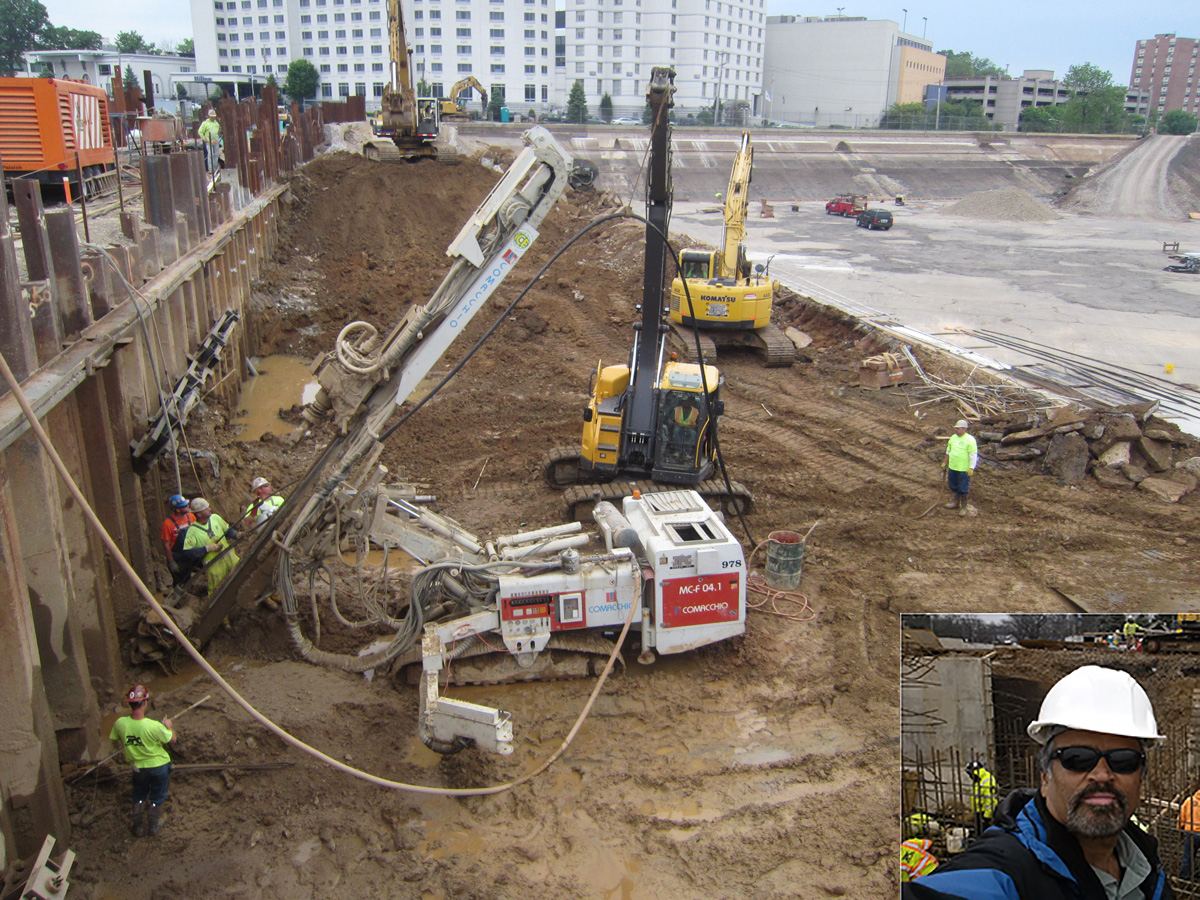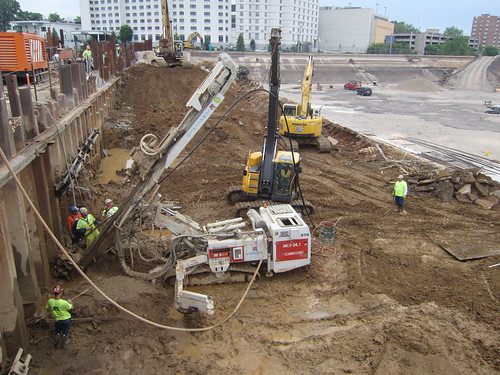
Above: Construction of the cofferdam at the Belmont River Water Basin. Inset: Resident Engineer Kam Patel. Credit: Philadelphia Water
In the public imagination, drinking water infrastructure usually comes down to two things: the drinking water treatment plants, and water mains that deliver the finished product to your tap.
In reality, the infrastructure it takes to treat hundreds of millions of gallons of water per day and get that top-quality water to 1.5 million people is far more complex, involving a variety of facilities along the way.
During Infrastructure Week 2016, we’ve been looking at some important infrastructure projects—all of which are funded solely by your water bill—that might get overlooked.
One such project is the renovated Belmont Raw Water Basin, which is in its final stages after years of work.
To give you an idea of how long this basin has been helping to provide Philadelphia with drinking water from the Schuylkill River, consider that Theodore Roosevelt became president the year construction began.
Check out amazing historic photographs of the original construction site here:
From a technical standpoint, the roughly 13-acre basin serves as the first step (not counting source water protection) in treating drinking water at the Belmont Drinking Water Plant, which can deliver as much 86 million gallons of crystal-clear water to residents per day.
(You can learn more about the intense treatment process that follows here and in this video.)
Like all water infrastructure, the Belmont Raw Water Basin was built to last. But, after more than a century of service, it was in need of a major revamp to ensure efficient and reliable operations.
Resident Engineer Kam Patel has been working for Philadelphia Water since 1993 and is on the crew in charge of making sure the Belmont Raw Water Basin project gets done.
He answered a few questions about what makes this massive project important and what sort of challenges drinking water engineers face as they maintain infrastructure that was built more than century ago, but is still essential to the everyday operations of the city.
Watersheds Blog: When was the Belmont Raw Water Basin built, and what role does it play in making water from the Schuylkill River safe to drink?
KP: The Belmont site consists of two basins, which were built around 1901. They allow silt, sediment, sand and other large particles to settle out from the raw river water before it enters the plant for processing and filtration. The basins also store 50-plus million gallons of water and provide the pressure needed to push raw water through the filtration process without additional (forced) pumping.
Watersheds Blog: What repairs need to be made, and when did Philadelphia Water start working on the project? When do we expect the work to be finished?
KP: The project includes construction of a new connector flume and dividing dike that serves to both separate the basins and bring water into each of them. The new flume was constructed with inlet and outlet chambers on either end. The raw water basin’s floor and sides have been restored with a new liner and soil cement material. Work started in March 2013, and the approximate completion date is March 2017.
Watersheds Blog: Can you give an estimate of how many people are needed to do a job of this size?
KP: It varies, but an average 20 people worked daily from beginning to end.
Watersheds Blog: From an engineering perspective, what challenges have you experienced?
KP: Building a double-walled, 20-foot wide temporary cofferdam (an enclosure constructed within the basin to allow the enclosed area to be pumped out, creating a dry work environment) to divide basin was a big challenge. We used 70-foot long sheet pile (large metal panels), which were driven down to the bedrock and needed 100-foot long “tie backs” to support them. That created a wide wall with 25 feet of raw water on one side, and a dry area for us to work in on the other.
Lastly, varying temperatures were one of the biggest problems during construction, making pouring concrete, placing soil cement on the slope, etc. challenging during hot summers and cold winters that included and rain and snow.
See photos of the cofferdam, basin, and more here:
Watersheds Blog: What makes this infrastructure project unique?
KP: Building the new dividing dike/flume without putting Belmont Drinking Water Treatment Plant out of service—that’s a challenge you don’t come across very often.
Watersheds Blog: Does a project this big, with so much water, require you to use special technology and tools?
KP: We had to use a special “dewatering” system and installed a dozen pits inside the cofferdam along the full length of the dam, and then “dewatered” the area 24/7 for more than three years!
Watersheds Blog: We heard that a few big fish made a home there. How did you deal with that?
KP: We found a few migratory species there, and saved them by taking them to the river. The remaining fish were transferred into newly the rehabbed east basin.
Watersheds Blog: What’s the most rewarding part of working on a big drinking water infrastructure project like this?
KP: When you work on 110-year-old water infrastructure, you run into unexpected situations. You can learn a lot from that. We handled all the problems we came across, step by step, through the collaboration of PWD colleagues and consulting engineers. For me, this is the most unique project I’ve worked so far in my career, and that’s very rewarding.
The Watersheds Blog sends a big thank you to Kam and his team for making this massive project a success and for taking the time to show us what it's all about. Be sure to look back at rest of our Infrastructure Week coverage, and stay tuned for more.

